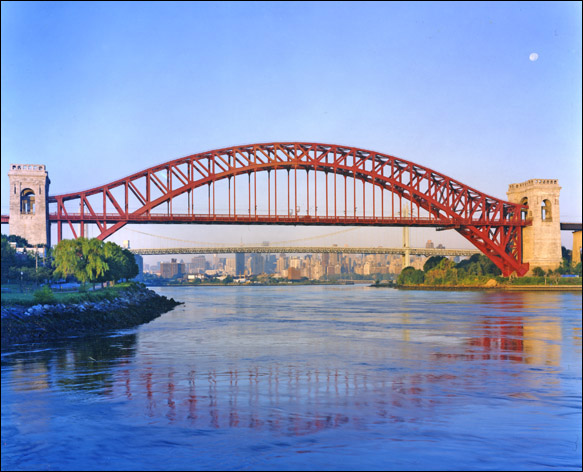| Where in the world is this bridge? If you
answer
"Sydney, Australia" you're wrong. If you guess
"Newcastle,
UK" or "Auckland, New Zealand" you're still
wrong. But if
you say "New York City" you've hit the jackpot.
It's the Hell
Gate Bridge, a 1,017-foot (310 m) steel arch carrying
railroad traffic
across part of the East River called Hell Gate.

Its revolutionary design caused a stir when it opened
officially on Sept.
30, 1916. Doomsayers at the time predicted it would
collapse, but it's
still in business, and will probably remain so for
centuries. It inspired
the construction of similar bridges around
the world.
The Hell Gate Bridge was designed by Gustav Lindenthal
(1850-1935), a
brilliant self-taught civil engineer. Born in Brno in what
is now the
Czech Republic, he had first worked as a mason and
carpenter. At 18, he
moved to Vienna, and found a job in the engineering
department of a
railroad company.
He never attended university, but taught himself
mathematics, engineering
theory, metallurgy, hydraulics, estimating, management,
"and
everything else that a successful bridge engineer needed to
know,"
quoting Henry Petroski's book, "Engineers of Dreams:
Great Bridge
Builders and the Spanning of America."
Lindenthal emigrated to the US in 1874. At first, he worked
as a
journeyman stonemason for the memorial granite building of
the Centennial
International Exhibition in Philadelphia, and later was
employed by the
Keystone Bridge Co. on numerous projects before being
recognized as a
gifted bridge engineer.
It's thought his early memories of a famous
bridge in Cologne (Koln), Germany, inspired his design
for the Hell
Gate Bridge.
Eminent bridge designers from other countries visited
Lindenthal and
marvelled at his radical ideas.
One of them was Australia's Dr. JJC Bradfield, lead
engineer in the New
South Wales Department of Works. When he returned home to
Sydney from a
six-month world tour in 1922, he changed the design for a
Harbor bridge
from an ugly cantilever to a graceful single-arched steel
structure.
Sydney Harbor Bridge (aka The Coathanger), opened in 1932,
is the world's
largest but not longest steel arch bridge. Its total
length, including
approach spans, is 1,149 metres and its arch span 503
metres. Its top is
134 metres high.
People had talked about building a bridge from the northern
to the
southern shore of the harbor since 1815, when the then
colony's government
architect, Francis Greenway, thought of one being needed
one day.
Various designs were considered and discarded for more than
a century.
Then in 1922 a general design was prepared by Bradfield and
officers of
the NSW Department of Public Works. The government called
for worldwide
tenders to build the bridge. The contract was let to Dorman
Long and Co of
Middlesbrough, UK.
Construction began in 1924, took eight years and employed
1,400 men. Six
million hand-driven rivets and 53,000 tonnes of steel were
used. The
bridge now carries eight traffic lanes and two railroad
tracks.
The Bridge was officially opened on March 19, 1932. Before
Premier JT Lang
could cut the ribbon, Captain Francis de Groot, a member of
a right-wing
political group called The New Guard, rode up on his horse
and slashed the
ribbon with his sword. He thought the Bridge should be
opened by a member
or representative of the Royal Family.
Police arrested him, and the Premier cut the hastily
repaired ribbon with
a pair of gold scissors.
The Tyne
Bridge in Newcastle-upon-Tyne, England is a smaller
version of the
Sydney Harbor Bridge, with a length of 397 metres and the
main span 161
metres.
"There is much controversy surrounding the two
bridges, and which one
may have been a model for the other," says an
Australian government Web
site.
"Although the Tyne Bridge was opened in 1928 - four
years before the
Harbour Bridge was opened - the tender was submitted and
contract signed
for the Sydney Harbour Bridge in March 1924. The designs
for the Harbour
Bridge were put forward by Dr. J C Bradfield before this
date. The tender
for the Tyne Bridge was accepted and contract signed later
that year in
December 1924."
Three final points:
- Actor/comedian Paul Hogan was once a rigger on the
Sydney Harbor
Bridge.
- A few weeks ago, the luxury liner Queen Mary II,
the largest ship
to visit Sydney, was too tall to go under the Harbour
Bridge and too
long to dock at the International Passenger Terminal
at Circular
Quay.
- The world's longest steel arch is the Lupu
Bridge 550m. (1,804ft.) in Shanghai, China,
according to a list
of longest spans published by
Wikipedia.
|




